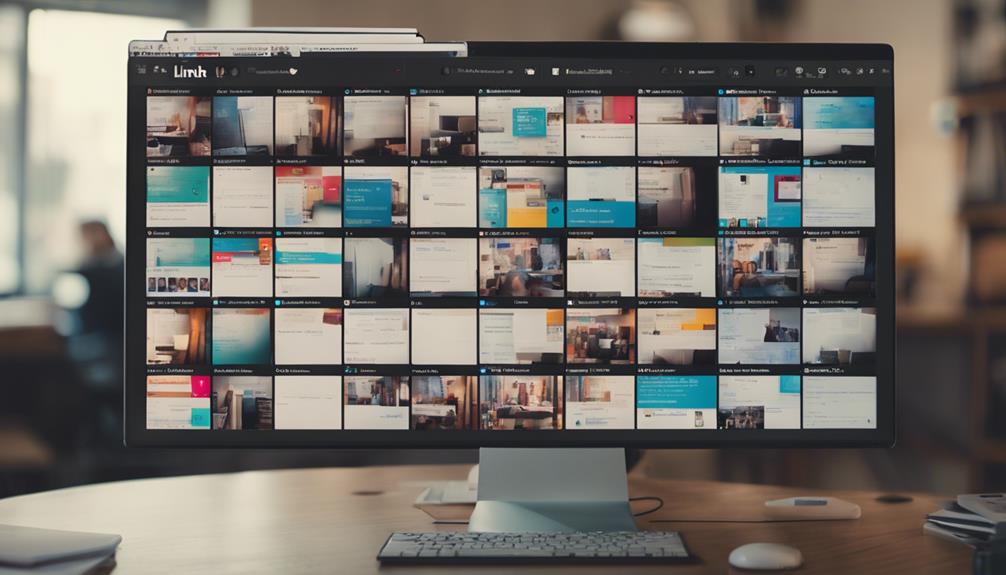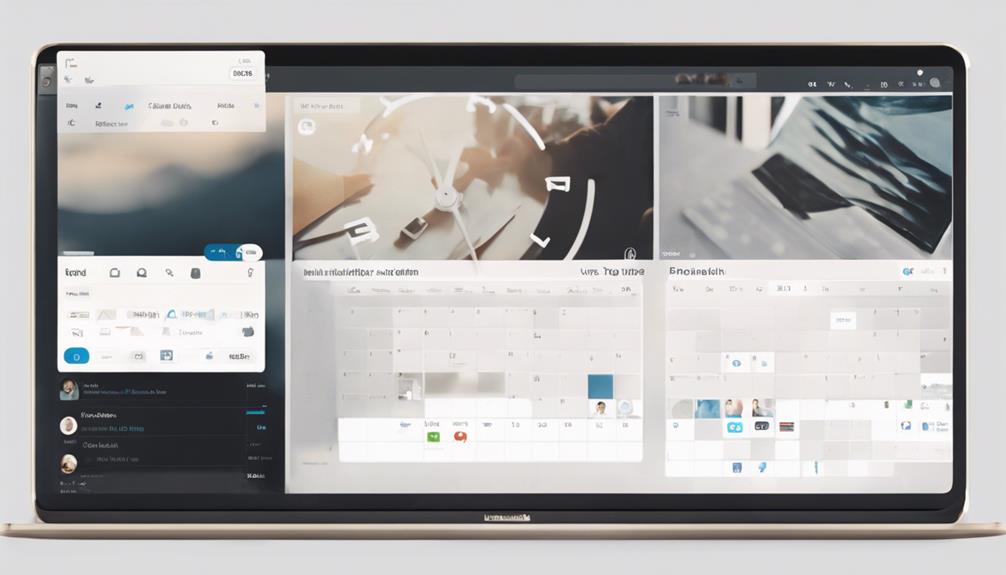
To effortlessly manage your archived LinkedIn posts, start by categorizing them using specific hashtags, such as #industrynews or #companyupdates, keywords, or folders, like ‘Thought Leadership’ or ‘Product Announcements’.
Regularly back up your posts to prevent data loss and utilize LinkedIn’s archive feature to keep your content organized by date, topic, or type.
Monitor post engagement metrics, including likes, comments, and shares, to refine your content strategy and adjust it based on performance, identifying top-performing content types, such as videos or infographics.
Finally, regularly review and update your archived posts to ensure they remain relevant and accurate, reflecting changes in your organization, industry, or target audience.
By implementing these strategies, you’ll be able to breathe new life into your old posts and discover ways to drive even more engagement and visibility from your archived content, ultimately enhancing your personal brand or company’s online presence.
Categorizing Your LinkedIn Posts

To maximize the visibility and impact of your LinkedIn posts, start by categorizing them into clear themes or topics that resonate with your audience. This simple step helps you organize your posts in a way that makes sense to your followers, making it easier for them to find and engage with the content that matters most to them.
So, how do you categorize your LinkedIn posts effectively? One way is to use specific hashtags or keywords that align with your content themes. This helps you create a clear taxonomy of your posts, making it easy to identify patterns and trends in your content.
You can also create folders or labels within your LinkedIn profile to sort your posts into different categories. This visual organization system allows you to group related posts together, making it easy to access and share them with your audience.
Additionally, utilize LinkedIn’s tagging features to group related posts together, creating a seamless user experience for your followers. By categorizing your posts, you’ll be able to showcase your expertise and thought leadership in a clear and concise manner, ultimately driving more engagement and visibility for your content.
Backup and Archiving Strategies
To ensure your valuable content remains accessible and doesn’t get lost over time, implement a robust backup and archiving strategy for your LinkedIn posts. You’ve worked hard to create engaging content, and it’s essential to safeguard it.
Regularly backing up your posts prevents data loss and ensures you can access them whenever needed. Using LinkedIn’s archive feature in tandem with exporting your data for additional backup options will provide a comprehensive record of your social media presence.
When archiving your posts, save them as HTML to retain likes and comments. This allows you to track engagement metrics over time, providing valuable insights into what resonates with your audience. By doing so, you can refine your content strategy and create more impactful LinkedIn posts.
Utilizing LinkedIn’s Archive Feature

You can safeguard your valuable content and maintain a comprehensive record of your LinkedIn presence by utilizing the platform’s built-in archive feature, which allows you to save a copy of your long-form posts along with their likes and comments for future reference. This feature is a game-changer for professionals who want to keep their content organized and easily accessible.
By archiving your posts, you can ensure that your valuable content doesn’t become outdated or lost over time. Plus, you can categorize and organize your posts more effectively, making it easier to find specific content when you need it.
Additionally, regularly backing up your archived posts provides an extra layer of security, ensuring that your content is safe even if changes occur on LinkedIn. By utilizing LinkedIn’s built-in messaging archiving and post archiving features, you’ll have control over your content and can rest assured that your valuable posts are secure and easily accessible.
Monitoring Post Engagement Metrics
Monitoring Post Engagement Metrics
Your archived posts provide a wealth of engagement metrics, enabling you to track reactions (e.g., Like, Celebrate, Support, Funny, Love, Insightful, and Curious), comments, and shares on each post, thus accurately gauging engagement levels. By doing so, you can identify which posts resonated with your audience and which ones did not.
Utilize LinkedIn’s analytics tools to monitor post views (impressions), clicks, and engagement rates over time. This helps you understand what’s effective and what’s not, allowing you to refine your content strategy accordingly.
Compare engagement metrics between different post types (e.g., industry news, thought leadership pieces, videos, events) to identify trends and preferences among your audience. Analyze the demographics (e.g., job title, industry, location, seniority, company size) of users interacting with your archived posts to tailor future content to your target audience.
If you find that certain posts receive little to no engagement, don’t hesitate to archive or categorize them as less relevant, adding a private comment explaining your decision. Regularly reviewing engagement metrics will help you adjust your content strategy to better resonate with your connections.
Maintaining Post Relevance and Accuracy

Regularly reviewing and updating your archived LinkedIn posts is crucial to ensure accuracy and relevance, as outdated information can negatively impact your professional brand. You wouldn’t want your professional network to stumble upon an old post that no longer reflects your current views or expertise.
Consider adding disclaimers or updates to old posts to reflect any changes in information or opinions. This will show your audience that you’re committed to providing accurate and reliable information.
You can utilize tools like Wayback Machine to track changes in your posts over time. This way, you can easily identify which posts need updates or removal. By doing so, you’ll be able to add or remove posts that are no longer relevant, ensuring your feed remains fresh and engaging.
Don’t be afraid to ask for feedback from your audience, either. If you find that a post is unhelpful or outdated, don’t hesitate to make changes. Remember, feedback is never shared, so encourage your audience to provide input to help you refine your content.
Frequently Asked Questions
Should I Delete Old Linkedin Posts?
Should you delete old LinkedIn posts? Think twice. Don’t erase your online presence and credibility. Those posts might still be relevant and valuable for showcasing your expertise.
Instead of deleting, consider archiving them. This way, you’ll maintain a comprehensive profile, preserve engagement data, and showcase your professional growth over time.
How Do I Get the Most Out of My Linkedin Posts?
To maximize the impact of your LinkedIn posts, start by saving them as HTML to preserve likes and comments, ensuring that your social media engagement metrics remain intact.
Then, develop a categorization system, such as a spreadsheet or content calendar, to easily find specific content and identify trends.
Regularly back up your posts to avoid losing valuable information, which can be crucial for tracking engagement metrics and understanding what resonates with your target audience, including industry professionals and potential clients.
Is It Better to Post on Linkedin With or Without Image?
When it comes to posting on LinkedIn, you’re probably wondering if you should include an image or not. The answer is clear: go for it. Visual content boosts engagement by 200%, making your post more visible and memorable to your audience.
According to LinkedIn, posts with images receive 2x more engagement than text-only posts. This is because images capture attention in a predominantly text-based feed, break up lengthy text, making your post more visually appealing, and convey emotion and context, rendering your update more relatable and engaging.
How to Structure Your Linkedin Post?
When structuring your LinkedIn post, key considerations include:
- Capture Attention: Start with an eye-catching introduction that includes visuals like images, videos, or infographics.
- Concise Writing: Use a clear and concise writing style that breaks up text with bullet points, headings, and subheadings, making it easy on the eyes.
- Credibility: For professionals like lawyers, avoid jargon and maintain a client-centric tone that resonates with your target audience.
- Storytelling: Write in the first person, using ‘I’ and ‘we’ to establish personal connections and make your content more compelling.
- Interaction: End with a call-to-action like a thought-provoking question or a how-to to encourage engagement and conversation.
- Organization: Limit hashtags to five and place them at the end of the post; avoid using links in the body as LinkedIn prioritizes keeping users on its platform.
- Tone: Use conversational language and avoid overly formal or technical language, ensuring that your content is easily accessible.
- Maximum Impact: Focus on ‘How-To’ and ‘List’ posts that get 3-5 times more engagement, and include specific action steps that readers can take away.
- Audience Relevance: Be client-centric and ensure that your content addresses specific pain points or interests relevant to your target audience.
- Clarity: Master the art of structuring by using one key message per post, a memorable first sentence, and positive endings to keep readers engaged.
Conclusion
Effortlessly Manage Your Archived LinkedIn Posts: Tips and Tricks
Master the art of effortlessly managing your archived LinkedIn posts.
Categorize, back up, and utilize LinkedIn’s archive feature.
Stay on top of your LinkedIn game, ensuring your archived posts remain a valuable resource for your professional online presence.






